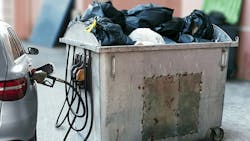Food Scraps, Sewage and Sludge Create Sustainable Fuels and Chemicals
“Rather than disposing of biomass waste in a landfill, we can use this renewable resource as a raw material,” says Holtzapple in a press release. “This can significantly impact society by providing a valuable way to utilize wastes, which helps the environment, addresses global warming, enhances human health and alleviates the need for fossil fuels.”
The release notes that Holtzapple refers to his method as the MixAlco process. In his process, biomass — waste paper, municipal solid waste, sewage sludge, animal manure, food scraps or purpose-grown energy crops — is added to a plastic or concrete tank. The biomass is inoculated with soil, which naturally contains microorganisms that decompose the biomass into organic acids ranging from two-carbon acetic acid (commonly known as vinegar) to eight-carbon octanoic acid (commonly known as caprylic acid).
According to Holtzapple, the key to the MixAlco process is to add an inhibitor in the tank to prevent methane production, which would normally occur in conventional biomass digesters. As the biomass sits in the tank, organic acids accumulate that can be recovered.
About the Author
Traci Purdum
Editor-in-Chief
Traci Purdum, an award-winning business journalist with extensive experience covering manufacturing and management issues, is a graduate of the Kent State University School of Journalism and Mass Communication, Kent, Ohio, and an alumnus of the Wharton Seminar for Business Journalists, Wharton School of Business, University of Pennsylvania, Philadelphia.

